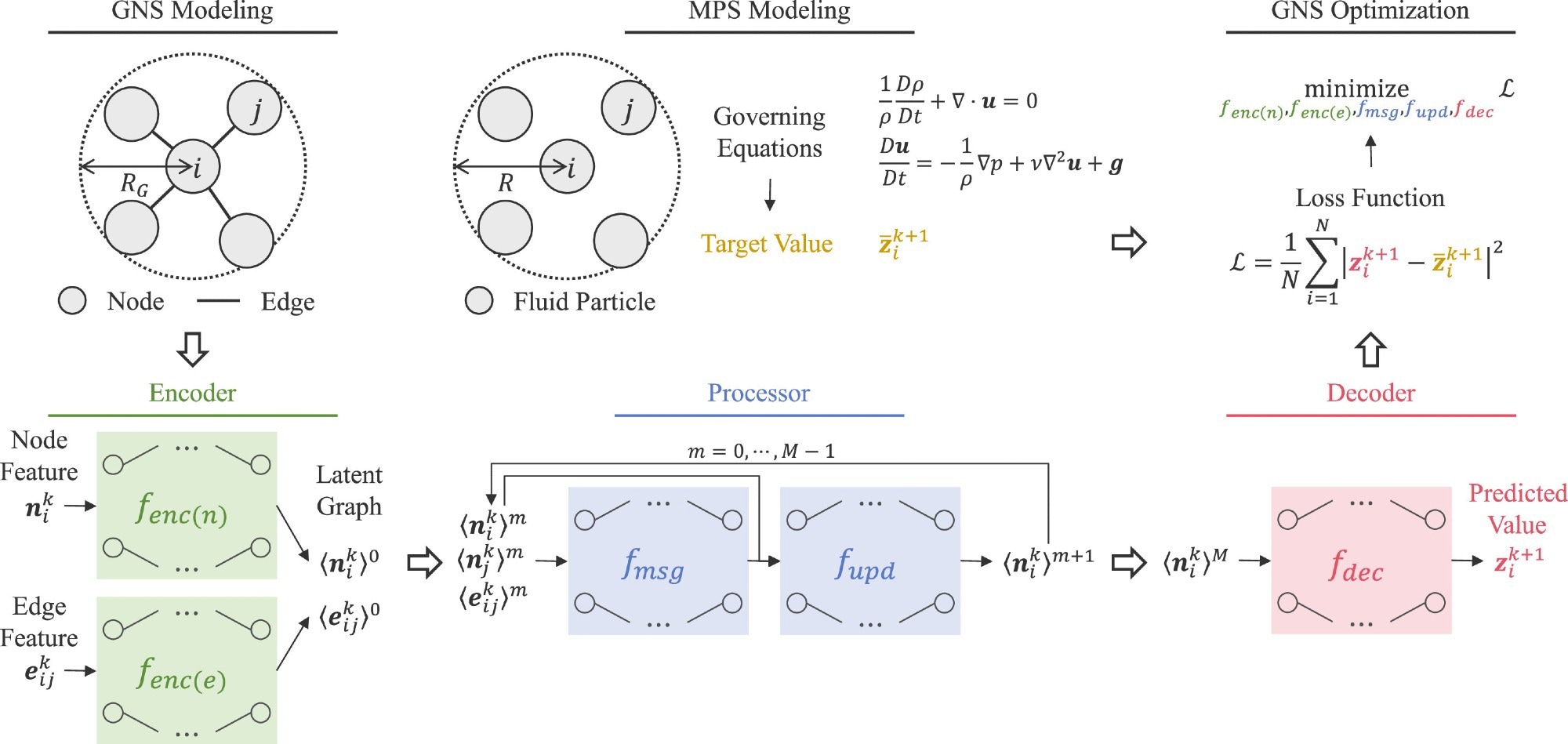AI breaks through the high-computation barrier in fluid simulation, offering ultra-fast, high-fidelity modeling that could transform offshore energy systems, vessel design, and real-time ocean monitoring.
 Overview of GNS. In GNS, a node represents a fluid particle, and an edge represents the interaction between particles. The nodes within the range of the connectivity radius RG are regarded as neighbors, in the same manner as MPS. First, edges are constructed among the neighboring nodes at every time step k. Second, node and edge features are computed. Third, the encoders generate a latent graph from the features. Fourth, the processor updates the latent graph in the framework of message passing, which is conducted M times. Fifth, the decoder predicts desired values (in the original GNS, the accelerations are estimated). Last, each network is updated to minimize the loss function, i.e., the error from the target values obtained by particle methods.
Overview of GNS. In GNS, a node represents a fluid particle, and an edge represents the interaction between particles. The nodes within the range of the connectivity radius RG are regarded as neighbors, in the same manner as MPS. First, edges are constructed among the neighboring nodes at every time step k. Second, node and edge features are computed. Third, the encoders generate a latent graph from the features. Fourth, the processor updates the latent graph in the framework of message passing, which is conducted M times. Fifth, the decoder predicts desired values (in the original GNS, the accelerations are estimated). Last, each network is updated to minimize the loss function, i.e., the error from the target values obtained by particle methods.
AI has created a sea change in society; now, it is setting its sights on the sea itself.
Researchers at Osaka Metropolitan University have developed a machine learning-powered fluid simulation model that significantly reduces computation time without compromising accuracy. Their fast and precise technique opens up potential offshore power generation, ship design, and real-time ocean monitoring applications. The study was published in Applied Ocean Research.
Accurately predicting fluid behavior is crucial for industries relying on wave and tidal energy and for designing maritime structures and vessels. While particle methods, which allow particles to simulate fluid flow behavior, are a common approach, they require extensive computational resources, including processing power and time. AI-powered surrogate models are making waves in fluid dynamics research by simplifying and accelerating fluid simulations.
However, AI is not without its flaws.
"AI can deliver exceptional results for specific problems but often struggles when applied to different conditions," said Takefumi Higaki, an assistant professor at Osaka Metropolitan University's Graduate School of Engineering and lead author of the study.
Aiming to create a consistently fast and accurate tool, the team developed a new surrogate model using a deep learning technology called graph neural networks. The researchers first compared different training conditions to determine what factors were essential for high-precision fluid calculations. They then systematically evaluated how well their model adapted to different simulation speeds, known as time step sizes, and various types of fluid movements.
The results demonstrated strong generalization capabilities across different fluid behaviors.
"Our model maintains the same level of accuracy as traditional particle-based simulations, throughout various fluid scenarios, while reducing computation time from approximately 45 minutes to just three minutes," Higaki said.
This research marks a step forward in high-performance fluid simulation, offering a scalable and generalizable solution that balances accuracy with efficiency. Such improvements extend beyond the lab.
"Faster and more precise fluid simulations can mean a significant acceleration in the design process for ships and offshore energy systems," Higaki said. "They also enable real-time fluid behavior analysis, which could maximize the efficiency of ocean energy systems."
The authors declare that they have no known competing financial interests or personal relationships that could have appeared to influence the work reported in this paper.
Source:
Journal reference:
- Higaki, T., Tanabe, Y., Hashimoto, H., & Iida, T. (2024). Step-by-step enhancement of a graph neural network-based surrogate model for Lagrangian fluid simulations with flexible time step sizes. Applied Ocean Research, 154, 104424. DOI: 10.1016/j.apor.2025.104424, https://www.sciencedirect.com/science/article/pii/S0141118725000124